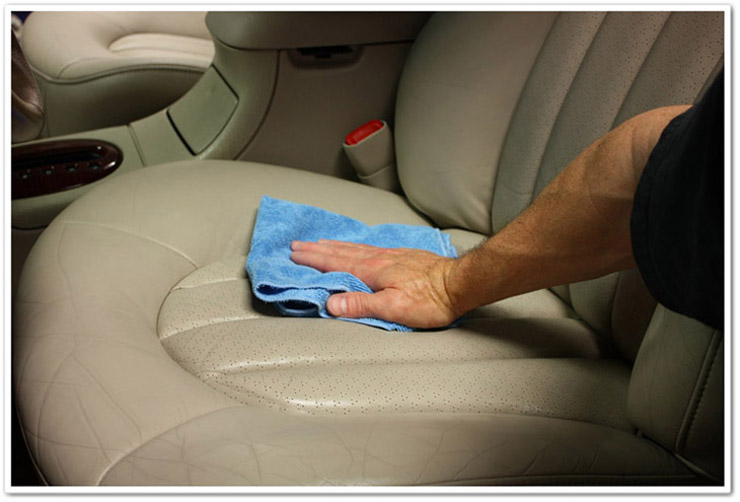
If you use your car every day, the upholstery won't look as elegant as it did when you first bought it. But if you clean the upholstery regularly, you can maintain a fresh interior for those daily commutes.
Know how to clean a mess
Michael Wilson, CEO of Fibrenew (a leather and plastic restoration company), said, "Kids and adults trying to juggle food, drinks and toys on the road can cause damage to car seats, but often times the worst problems are caused by car owners who don't know the best ways to clean up a mess and repair a problem."
Knowing how to care for your upholstery essentially means knowing the appropriate product for the surface. These substances have been developed to properly cleanse leather, carpet, rubber or vinyl, so you don't want to apply one to the wrong surface at the risk of irreparable damage. There is no catch-all product that should be used for the upholstery of every car, but before applying the products, every car's interior should get a thorough vacuuming.
Vacuum
The best way to keep your car's upholstery looking good is general maintenance.
Cary Zelich, market manager at automotive maintenance manufacturer ITW Permatex, recommends vacuuming as regularly as you would your home because it "lifts the fibers back upright and also prevents the deep set-in of dirt."
However, you won't be able to use the same vacuum that you purchased for your living room rug. There are special car vacuums with interchangeable parts, designed to reach the various nooks of your automobile. When you vacuum, remember to remove any mats that could obstruct a thorough cleaning. Vacuum beneath the mat and then vacuum just the mat before putting it back in the automobile.
Leather
With leather upholstery, you should only use a damp towel for minor food or drink stains, before any spill soaks through the leather. Experts at Fibrenew noted that fully-finished leather is largely water resistant, so if you clean the spill early enough, it won't require much.
For stains that have set or to get rid of harsh materials (nail polish, ink), you will need to use a leather cleaner and a soft sponge. You should avoid anything harsh that hasn't been made specifically for leather, such as dish soap, hairspray or window cleaner.
For car scratches in leather, Fibrenew suggested snipping off the protruding cotton strands from the interior, blowing a hair dryer on the scratch and massaging it with a leather cleanser.
Rubber and vinylRubber and vinyl will require particular cleaning materials. Like leather, there are specialty cleaners made specifically for these surfaces. There are home remedies as well.
Zelich recommended cleaning vinyl seats by wiping them with baking soda on a damp rag and then rinsing with dish-washing detergent and water. She explained, "Baking soda is gentler on vinyl than oil-based cleaners, which can cause the vinyl to harden."
Bob "Max" McKee, CEO and Founder of the Palm Beach Motoring Group, reported that rubber and vinyl are particularly vulnerable to deterioration caused by the sun. You should invest in an interior protectant, which is available at many car supply stores.
CarpetThe carpet goes through more contact than the rest of your interior. Every day, you step on it, and after a short time, this begins to show. You should take precautionary measures by spraying your carpet with stain repellents. Also, you need to ensure that you use quality stain repellents because inferior or knock-off products could prematurely age your carpet without offering much protection at all. If you do get a stain on your carpet, use a spot remover that has been specifically developed for carpets.




 In 1955, San Francisco police officer Marvin Zukor drove his 1934 Packard V12 Convertible Victoria about 100 miles down the California coast to participate in the third Pebble Beach Concours d’Elegance. Fifty-three years later, Zukor and his prized possession will again be competing in the August 17 Concours, which has grown from a local collector car show into an annual showcase for classic automobiles from around the world.
In 1955, San Francisco police officer Marvin Zukor drove his 1934 Packard V12 Convertible Victoria about 100 miles down the California coast to participate in the third Pebble Beach Concours d’Elegance. Fifty-three years later, Zukor and his prized possession will again be competing in the August 17 Concours, which has grown from a local collector car show into an annual showcase for classic automobiles from around the world. Zukor, who will be attending the 2008 Concours with his wife Vivian and her two children, was invited to return to the event by Chris Bock, a longtime friend and a member of the Pebble Beach Selection Committee. Bock says that his committee loves the fact that the car has been used its entire life and “for most of the past 53 years, Marvin has been pouring oil into the car and driving it around northern California.
Zukor, who will be attending the 2008 Concours with his wife Vivian and her two children, was invited to return to the event by Chris Bock, a longtime friend and a member of the Pebble Beach Selection Committee. Bock says that his committee loves the fact that the car has been used its entire life and “for most of the past 53 years, Marvin has been pouring oil into the car and driving it around northern California.